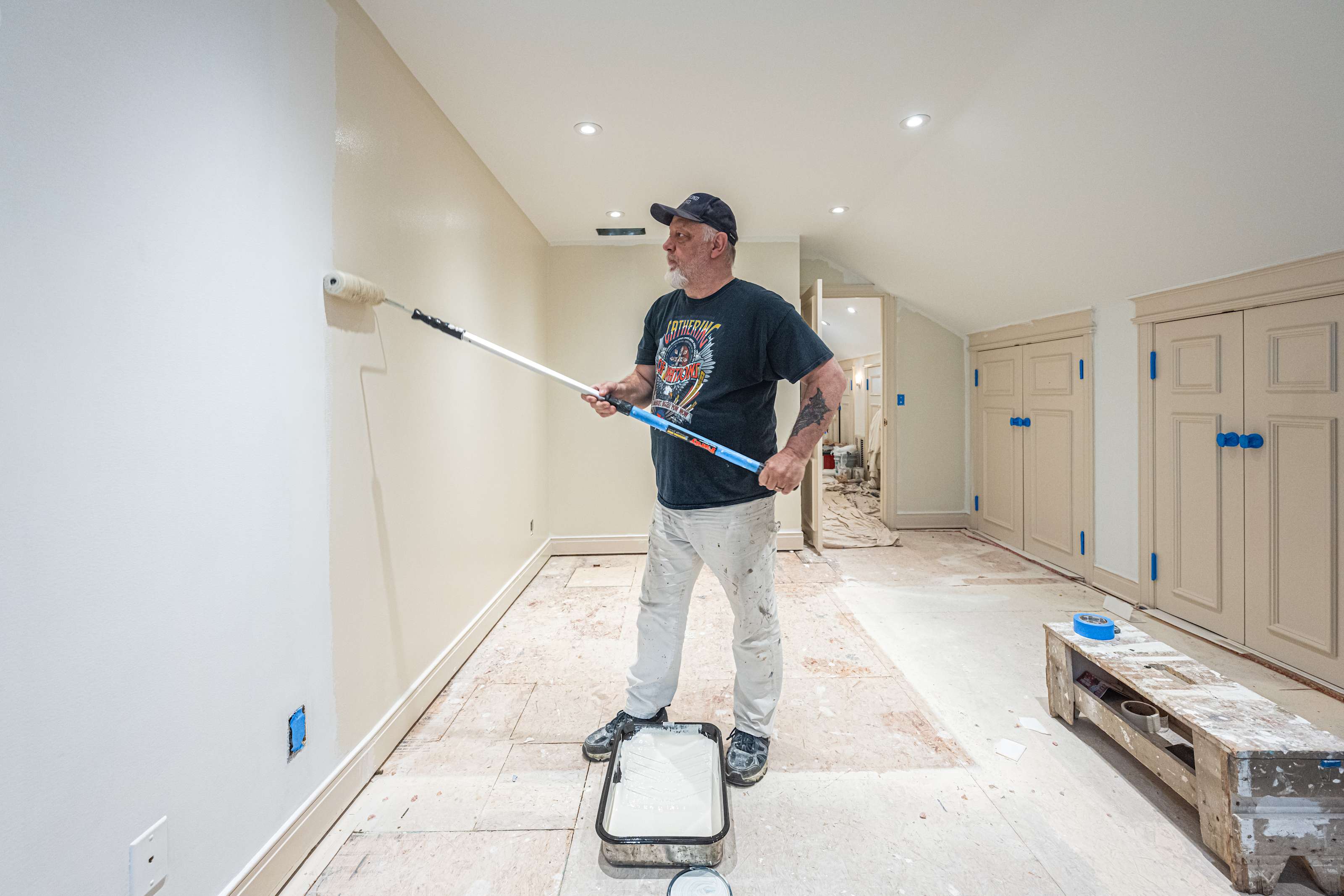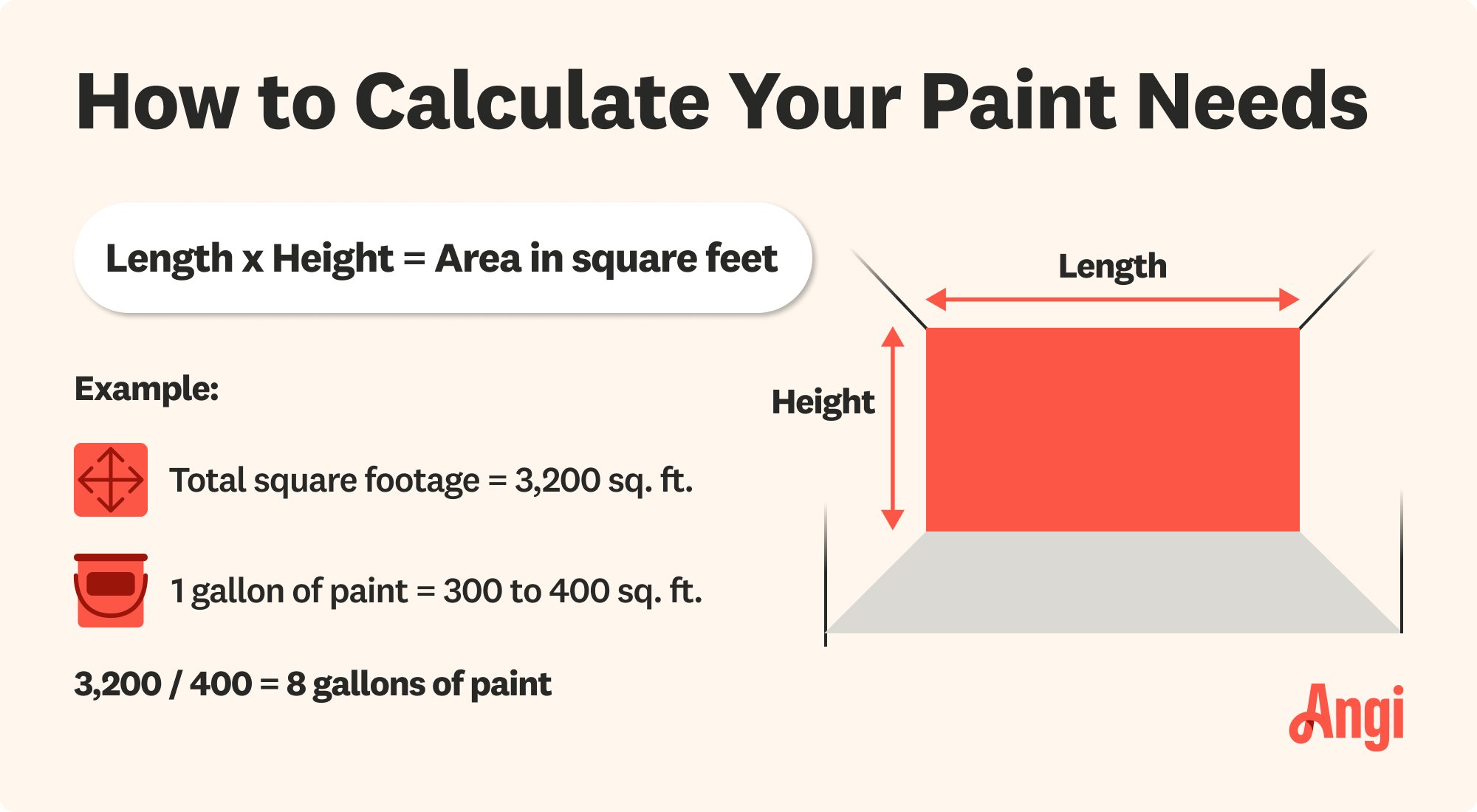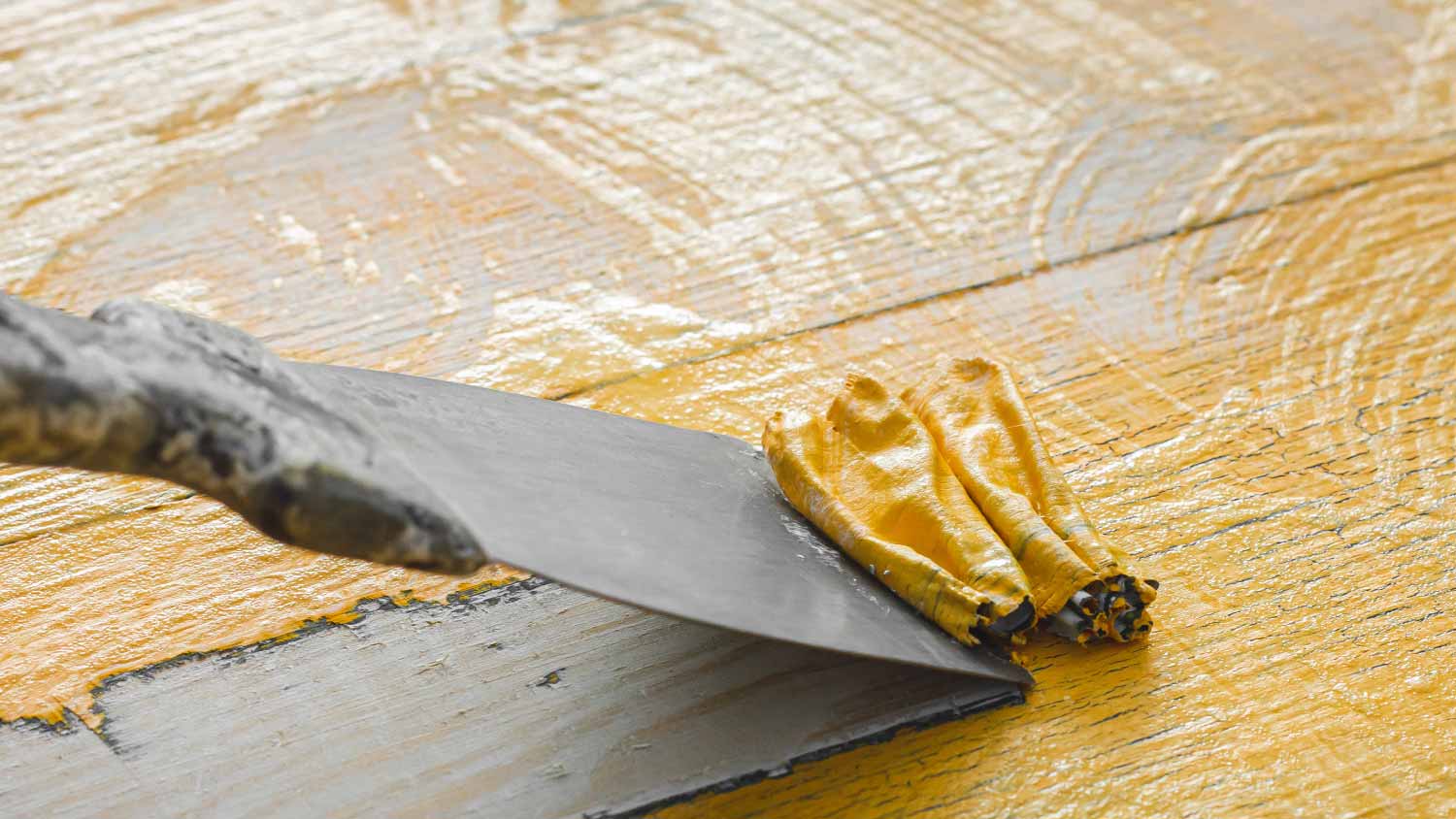
How much does it cost to paint a room? Learn what you’ll pay to give your space a makeover, depending on room size, paint type, the pro you hire, and more.
Interior painting costs depend on your project and location. Check with a local pro for your specific job.
Painting the interior of a 500-square-foot home typically costs $200 to $1,000, depending on paint type and labor.
A 1,000-square-foot home will generally have interior painting costs between $2,000 and $6,000.
Painting add-ons, such as installing crown molding, can range from $600 to $2,100.
Replacing interior windows while painting can increase your budget by $3,400 to $11,700.
Hiring professionals for labor and prep work accounts for the majority of costs, with drywall repairs adding an average of $600 when needed.
The average cost to paint the interior of a house is $2,022, with a total range of $350 to $5,800, depending on your area, type of paint, and square footage. The biggest factor affecting your cost is home size, as you’ll pay between $2 and $6 per square foot.
Whether your beloved home just needs a refresh or you’re planning to paint your home before putting it on the market, let’s review the average cost to paint the interior of a house so that you can set your budget properly.
There are a few key factors to consider if you want to get the most accurate estimate for painting the interior of your home.
Across the country, the average cost to paint the interior of a house is $2.75 per square foot. If you include walls, trim, and ceilings, the cost per square foot is $4.70. To get the most accurate quote, have your square footage ready when speaking with a pro. For reference, an average room is 10-by-12 feet.
If you’re embarking on a whole-house interior painting project, check out the cost to paint a home interior by square footage, ranging from $2 to $6 per square foot:
| Size of Home (per Sq. Ft.) | Average Cost |
|---|---|
| 500 | $200–$1,000 |
| 800 | $1,600–$4,800 |
| 1,000 | $2,000–$6,000 |
| 1,200 | $2,400–$7,200 |
| 2,300 | $4,600–$13,800 |
| 2,500 | $5,000–$15,000 |
| 3,000 | $6,000–$18,000 |
Painting costs vary for different surfaces. Whether you're planning to refresh your walls, revive your ceilings, or give your trim a new lease on life, knowing the average expenses per surface type can help you budget effectively. In addition to walls and ceilings, you may also choose to paint baseboards and trim or paint an accent wall.
Adding an accent wall increases the budget for the room by 20% to 30% to cover the cost of additional paint and materials. Choosing to add an accent wall will also require additional taping and drying time, so the cost to paint an accent wall will sit higher than a wall that will match the others in your home.
| Surface | Average Cost to Paint |
|---|---|
| Baseboard and trim | $1–3 per linear foot |
| Hard-to-reach areas | $6 per sq. ft. |
| Smooth ceiling | $1–3 per sq. ft. |
| Walls | $1–2 per sq. ft. |
| Accent Walls | $2–$6 per sq. ft. |
While browsing the paint aisle or speaking with your pro, you’ll probably notice that paint costs about $15 to $40 per gallon, depending on the brand and paint finish. If you have your heart set on a specific brand name or type of paint, it can raise the price pretty quickly. Long-lasting paint, high-gloss paint, and stain-blocking or mold-resistant paint will usually cost more and can push up your material costs.
The average home needs about 6 gallons of paint per coat, excluding primer, so keep that in mind before filling up your cart.
| Paint Type | Average Cost (Per Gallon) |
|---|---|
| Primers | $10 |
| Flat paint | $13 |
| Semi-gloss interior paint | $17 |
| High-gloss enamel paint | $35 |
| VOC-free paint | $35 |
Another important thing to consider is your ceiling height. Walls under standard 8-foot ceilings will be the most affordable to paint. Taller walls, especially those under cathedral ceilings, will often require scaffolding and additional safety equipment to paint. These can drive up your labor costs even beyond what the additional coverage will add.
Professional painters include the cost of labor in the total estimate, which often accounts for between 75% and 95% of the total cost. While there’s no substitute for a professional paint job, you can cut down on labor costs by patching and prepping your walls so they’re ready for painting when the pros arrive.
If a wall requires sanding and patching, the cost for wall prep is between $0.50 and $0.75 per square foot. This prep work is vital for a smooth finish on your wall, so a pro can apply paint flawlessly.
Some paint contractors bundle the prep work into their hourly or per-square-foot charges. If a room requires drywall fixes before the paint can glide on, drywall repair costs can add an average of $600 to your budget, depending on the severity.
You may need to use a primer prior to painting your walls, especially if you’re painting over a dark shade with a light shade. Paint primer helps the paint adhere more effectively, resulting in longer-lasting paint jobs and reducing how often you need to paint your home. Primer costs around $10 per quart and covers around 100 square feet with a single coat. Depending on your walls, you might need multiple coats of primer.
If your walls are a bit worse for wear, you may need to do some repairs to provide a clean slate for painting. Scratches, dents, and water stains are common issues you can tackle with spackle and a putty knife. Again, taking on this task yourself can save money over having your painter do the work.
Adding textured walls to create a richer look can hide paint flaws and add some depth to your space, but prepare to increase your painting budget by up to 50% for this premium technique. Textured walls can require double the amount of paint as a smooth wall. Before hiring a professional painter, ensure that they offer this specialized service.
Removing wallpaper costs around $3 per square foot. In a 12-by-12-foot room, expect to pay about $535 to tear down wallpaper.
Expect to pay between $1 and $2 per square foot to de-pop a popcorn ceiling. Once your professional removes your popcorn ceiling, extra costs for texture, painting, or other refinishing options will add to the final total. Contact a popcorn ceiling removal pro near you for assistance.
If the interior of your home features unique architectural designs such as archways or columns, painting these will affect the cost. Due to the complexity of the areas, the increase in cost is labor-focused, as it takes more keen attention to detail to make them shine.
The last thing you want is to get paint on your furniture, so you’ll want to move your beautiful velvet couch either to the center of the room (covered) or out of the room completely. To reduce labor costs when hiring a painter, move the furniture (if you can safely lift it!) before they get started.
The cost of painting the interior of your home varies with your location. Painting costs go mostly toward labor, so prices will vary based on the local cost of living to ensure painters earn a fair wage.

Measuring the square footage of each room you plan to paint is an essential part of the process. To calculate square footage, multiply the length of the room by the width in feet:
Length x Width = Area in square feet.
If the space isn't a perfect shape, section off the room to make squares or rectangles and measure each section at a time. Add the square footage areas together to get the total square footage of the room.
As a general rule of thumb to know how much paint you need, 1 gallon of paint is required per 300 to 400 square feet. If you have textured walls or choose thinner paint formulas, your project may require more materials.
To err on the side of caution, overestimate by purchasing 1 gallon per 300 square feet. To get a general estimation, use this equation:
Total square footage / 400 = Number of gallons of paint.
For example, if your house is 2,400 square feet, you would need 6 gallons of paint (2,400 / 400 = 6).
Oil-based paints contain higher volatile organic compounds (VOCs) than latex paints. To limit your exposure to VOCs while painting indoors, keep the area well-ventilated, wear respiratory protection, and avoid the painted area for at least 72 hours once finished.
While you’re budgeting for an interior refresh, you might want to consider the following add-on services to maximize the impact and increase home value even further.
Cost to replace light fixtures: $150 to $1,000
Cost to install crown molding: $600 to $2,100
Cost to refinish wood flooring: $1,100 to $2,700
Cost to replace interior doors: $360 to $1,200
Cost to replace windows: $3,400 to $11,700
Cost to replace kitchen cabinets: $2,000 to $11,000
Whether you decide to DIY your interior painting or hire a professional painter, you can use the tips below to reduce your overall costs.
Do the prep work yourself. Save on setup and cleanup by tarping off furniture and fixtures and tapping off the area ahead of time.
Carry out drywall repair if possible. Reduce the time painters spend on repairs by fixing holes or scratches in the walls before they arrive.
Paint trim and ceilings at the same time. You’ll spend more up front for these added services, but you’ll save overall since the painters will already be on-site for your walls.
Buy the materials yourself. Some painters might mark up materials, especially if they need to take a special trip to buy them. Purchase materials yourself instead to save a bit of money.
Be discerning about what you paint. Sometimes, it makes sense to paint the entire interior of your home, but you can also hire a pro to tackle only the main areas to get the biggest bang for your buck. You can then tackle the bedrooms that guests won’t see on your own.
Hiring a local painter costs more upfront, but you benefit from faster results, a flawless finish, and less risk of damage to walls or furnishings. Pros bring specialized tools and experience, making the process smoother and often saving you money on touch-ups or repairs.
Painting the interior of a house is a detailed project that requires skill and expertise. Here are some of the top reasons to work with a pro:
Interior painters ensure walls, trim, baseboards, and fixtures aren’t damaged during painting.
They have the brushes, rollers, sprayers, and techniques needed for a smooth, even coat on a variety of surfaces.
Working with a pro ensures your project is completed efficiently, accurately, and with a professional-quality finish.
Bundling painting with wall repairs, priming, or finishing work can save on overall labor and material costs.
If you want to take on parts of the project yourself, here are a few DIY tasks that can help save time and labor costs:
Move furniture away from walls and cover it with drop cloths to protect from paint splatters.
Remove outlet covers, light switch plates, and any wall-mounted décor before painting begins.
Patch small holes or cracks in walls so the painter can achieve a smooth finish more efficiently.
Be ready to provide details about your walls, including surface type, existing paint condition, and any problem areas like cracks or stains, as this helps your pro determine the prep work and materials needed.
If your budget allows, ask your pro about optional services like priming, textured finishes, accent walls, or specialty paints that improve durability or appearance.
Be prepared for unexpected costs, such as repairing drywall damage, patching holes, or addressing mold or water stains discovered during prep.
Discuss your timeline and room accessibility with your pro, as furniture removal, drying times, and multiple coats can affect how long the project takes.
Home is the most important place on earth, which is why Angi has helped more than 150 million homeowners transform their houses into homes they adore. To help homeowners with their next project, Angi provides readers with the most accurate cost data and upholds strict editorial standards. We’ve surveyed over 30,000 real Angi customers about their project costs to develop the pricing data you see, so you can make the best decisions for you and your home. We pair this data with research from reputable sources, including the U.S. Bureau of Labor Statistics, academic journals, market studies, and interviews with industry experts—all to ensure our prices reflect real-world projects.
Want to help us improve our cost data? Send us a recent project quote to [email protected]. Quotes and personal information will not be shared publicly.
From average costs to expert advice, get all the answers you need to get your job done.

How much does it cost to paint a room? Learn what you’ll pay to give your space a makeover, depending on room size, paint type, the pro you hire, and more.

Looking to breathe new life into your space with a ceiling refresh? Learn about the cost to paint a ceiling and what factors can affect your total.

An accent wall is a great way to elevate any room. Find out how much it costs to paint an accent wall and what factors affect how much you’ll pay.

Wondering who to hire to strip paint or remove paint? Compare paint stripping contractors and lead abatement pros, and start your project with confidence.

Painting plastic requires the right paint to get the job done flawlessly. Check out 11 of the best paints for plastic to help you with your next project.

You must choose the best paint for metal surfaces to get the smoothest and longest-lasting coverage. We’ve rounded up 12 of the best paints for metal items in this guide.